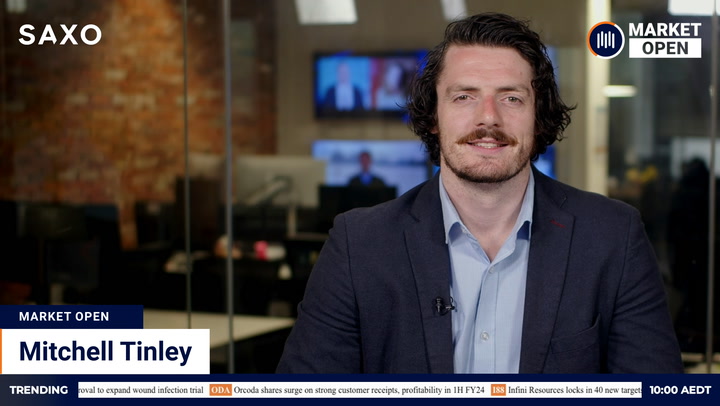The share market will shoot for a third straight advance after better-than-expected earnings from Tesla powered Wall Street to a six-week high.
Futures action suggests the S&P/ASX 200 could regain 6800 this morning for the first time since mid-June. SPI 200 futures edged up 12 points or 0.18 per cent. A late rally yesterday lifted the Australian benchmark 0.52 per cent to 6794.
Overnight, oil prices retreated, along with iron ore and copper. Gold bounced off a 15-month low. The dollar climbed back above 69 US cents.
Wall Street
US stocks rallied for a third night as buyers were encouraged by a weaker dollar and resilient corporate earnings.
The S&P 500 climbed 39 points or 0.99 per cent. The Dow Jones Industrial Average added 162 points or 0.51 per cent. The Nasdaq Composite led again, rising 162 points or 1.36 per cent.
The tech-heavy Nasdaq has led all week as investors sift through the wreckage of this year’s bear market for oversold assets. Last night’s gain extended this week’s rebound to 5.3 per cent. The S&P 500 has risen 3.5 per cent and the Dow 2.4 per cent.
“What you’re seeing in the market today is continued potential recovery, some continued potential optimism for numbers not being as bad as feared,” Robert Cantwell, portfolio manager at Upholdings, said. “But that’s been happening in the market now for almost a month.”
Tesla surged 9.78 per cent after price increases offset production delays. The electric carmaker’s result helped counter weak reports from AT&T and two of the major airlines.
The second-quarter reporting season has continued to deliver more positive than negative surprises this week. Refinitiv said 78 per cent of the 90 companies that have reported so far have beaten the consensus on earnings.
“The earnings picture has been maybe a little better than investors feared,” J Bryant Evans, investment adviser and portfolio manager at Cozad Asset Management, said. “We investors are thinking that… especially technology has come down too far, and maybe there’s some valuation opportunities there,” he added.
The greenback fell after the European Central Bank raised its benchmark rate for the first time in 11 years. The central bank surprised the market by hiking by 50 basis points. Traders had anticipated a smaller increase of 25 bp.
A weaker US dollar lowers commodity prices for holders of other currencies, and helps firms that depend most on overseas revenues, including tech firms.
The Federal Reserve meets next week and is expected to increase the federal funds rate target by 75 basis points to curb inflation. Last night’s economic data suggested rate rises were starting to impact the economy.
First-time claims for unemployment benefits rose to 251,000 last week, the highest since November. A gauge of manufacturing activity in the mid-Atlantic region fell to its weakest since May 2020.
Australian outlook
The S&P/ASX 200 is on track for its best week since March as this month’s tentative recovery gathers pace. Global recession fears have been pushed onto the backburner for now as investors bet central banks may pull off the difficult feat of bringing down inflation without killing growth.
Out-of-favour growth is back. The beaten-down BNPL sub-sector surged here yesterday. Overnight, tech and consumer discretionary (Tesla) led in the US.
Also strong were health +1.51 per cent, materials +1.4 per cent and financials +0.64 per cent.
That looks like a solid platform for ASX gains if investor sentiment survives the “Friday effect” (the desire to lock in profits before the weekend) and the fact a bumper US rate rise is now just days away (the Fed meets on Tuesday).
The domestic quarterly reporting season has yet to throw up any major new negative themes. Labour and supply-chain issues continue to dog miners, but these have been known issues for several seasons.
The dollar built on yesterday’s push above 69 US cents. The Aussie was lately up 0.71 per cent at 69.33 US cents. The unit has not settled that high in at least three weeks.
Preliminary July readings for manufacturing and services sector activity were due at 9 am AEST.
Miner sands miner Iluka Resources holds its AGM today in Perth.
Commodities
Oil pulled back to its lowest in a week after US gasoline inventories increased last week at a time when seasonal demand should be strong. Gasoline stockpiles rose by 3.5 million barrels, well ahead of expectations for the northern summer holiday “driving season”.
“Conservative oil investors have watched this movie before in 2008, when staggering oil prices dampened oil demand and led to a crash in oil prices,” Manish Raj, chief financial officer at Velandera Energy Partners, told MarketWatch. “It is easier for traders to stay on the sidelines until the demand picture is clearer.“
Brent crude settled US$3.06 or 2.9 per cent lower at US$103.86 a barrel. The US benchmark declined 3.5 per cent to US$96.35.
Iron ore continued to retreat amid questions over the pricing implications of China’s creation of a centralised steelmakers’ body to negotiate with suppliers.
The spot price for ore landed in China eased 74 US cents or 0.7 per cent to US$103.36 a tonne. The most-traded contract on the Dalian Commodity Exchange fell 0.3 per cent to 657 yuan.
Australian mining giants BHP and Rio Tinto traded mixed in overseas action. BHP‘s US-traded depositary receipts dropped 0.2 per cent. The miner’s UK stock fell 0.38 per cent. Rio Tinto bounced 0.4 per cent in the US and 0.03 per cent in the UK.
Gold logged its highest close in more than a week as the greenback and US bond yields eased. Metal for August delivery settled US$13.20 or 0.8 per cent ahead at US$1,713.40 an ounce. The NYSE Arca Gold Bugs Index rebounded 1.28 per cent.
Copper declined as investors factored in the risk of a European recession after the ECB announced its biggest rate rise since 2000.
“Clearly the focus of the market is now on demand destruction because of the rising recession risks,” Julius Baer analyst Carsten Menke told Reuters.
“The risks are clearly to the downside. Even though I think we have undershot, I would not bottom fish at these levels,” he added.
Benchmark copper on the London Metal Exchange fell 0.7 per cent to US$7,304 a tonne. Aluminium gave up 0.6 per cent, lead 1 per cent and zinc 2.8 per cent. Nickel firmed 1.4 per cent. Tin edged up 0.6 per cent.





